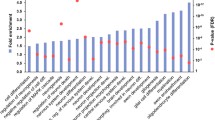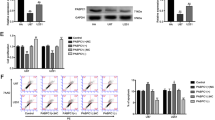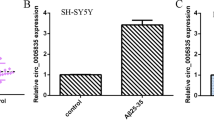Abstract
Brain-derived neurotrophic factor (BDNF) is a member of the neurotrophins family with well-known roles in neural development, differentiation, survival, and synaptic plasticity; however, it has not been explained thoroughly how the expression of this critical gene is regulated. To reveal some aspects of Bdnf gene regulation, here it was explored whether metastasis-associated lung adenocarcinoma transcript 1 (Malat1) and HOX transcript antisense RNA (Hotair) lncRNAs play roles in the regulation of Bdnf expression level, the effect of fingolimod treatment on downstream pathways, and oligodendrocyte precursor cell (OPC) maturation. First, in rat primary glial culture, the effect of Hotair and Malat1 was investigated on Bdnf expression using downregulation by specific DNAzymes. Then, immunostaining and RT-qPCR assays were employed to assess the functions of fingolimod and lncRNAs on OPC maturation. The results demonstrated that Bdnf was significantly correlated to Hotair and Malat1 lncRNAs in glial cells. Also, a strong correlation was observed between these two lncRNAs in glial culture and isolated OPCs. Fingolimod treatment coordinated lncRNAs' role on Bdnf expression in glial cells and enhanced OPC myelination three times compared to control. Furthermore, results suggested that Malat1 may have a role in the last stages of the intrinsic oligodendrocyte (OL) myelination regardless of fingolimod treatment. As BDNF is involved in brain development, survival, and functions, understanding the regulatory mechanism behind BDNF expression leads to a better comprehension of the pathogenesis of the neurodegenerative disorder and designing more effective treatments.





Similar content being viewed by others
Data availability
The data that support the findings of this study are available on request from the corresponding authors.
Code availability
Not applicable.
Abbreviations
- BBB:
-
Blood–brain barrier
- BDNF:
-
Brain-derived neurotrophic factor
- bFGF:
-
Basic fibroblast growth factor
- ceRNA:
-
Competitive endogenous RN
- CNS:
-
Central nervous system
- EGF:
-
Epidermal growth factor
- HOTAIR:
-
HOX transcript antisense RNA
- IGF-1:
-
Insulin-like growth factor 1
- lncRNA:
-
Long noncoding RNAs
- MALAT1:
-
Metastasis-associated lung adenocarcinoma transcript 1
- MREs:
-
MicroRNA-binding sites
- OL:
-
Oligodendrocyte
- OPC:
-
Oligodendrocyte precursor cell
- PDGF:
-
Platelet-derived growth factor
- PLL:
-
Poly-L-lysine
- T3:
-
Triiodo-L-thyronine
References
Miranda M, Morici JF, Zanoni MB, Bekinschtein P (2019) Brain-derived neurotrophic factor: a key molecule for memory in the healthy and the pathological brain. Front Cell Neurosci 13:363
Giacobbo BL, Doorduin J, Klein HC et al (2019) Brain-derived neurotrophic factor in brain disorders: focus on neuroinflammation. Mol Neurobiol 56:3295–3312
Ishii T, Warabi E, Mann GE (2019) Circadian control of BDNF-mediated Nrf2 activation in astrocytes protects dopaminergic neurons from ferroptosis. Free Radic Biol Med 133:169–178
Fontanesi C, Kvint S, Frazzitta G et al (2016) Intensive rehabilitation enhances lymphocyte BDNF-TrkB signaling in patients with Parkinson’s disease. Neurorehabil Neural Repair 30:411–418
Fletcher JL, Wood RJ, Nguyen J et al (2018) Targeting TrkB with a brain-derived neurotrophic factor mimetic promotes myelin repair in the brain. J Neurosci 0487–18. https://doi.org/10.1523/JNEUROSCI.0487-18.2018
Fletcher JL, Murray SS, Xiao J (2018) Brain-derived neurotrophic factor in central nervous system myelination: a new mechanism to promote myelin plasticity and repair. Int J Mol Sci 19:4131
Sospedra M, Martin R (2016) Immunology of multiple sclerosis. In: Seminars in neurology. Thieme Medical Publishers, pp 115–127
Lemus HN, Warrington AE, Rodriguez M (2018) Multiple sclerosis: mechanisms of disease and strategies for myelin and axonal repair. Neurol Clin 36:1–11
Duncan ID, Radcliff A (2020) Remyelination therapy for demyelinating disease. Nat Rev Neurol 1
Kıray H, Lindsay SL, Hosseinzadeh S, Barnett SC (2016) The multifaceted role of astrocytes in regulating myelination. Exp Neurol 283:541–549. https://doi.org/10.1016/j.expneurol.2016.03.009
Ponath G, Park C, Pitt D (2018) The Role of Astrocytes in Multiple Sclerosis. Front Immunol 9:217. https://doi.org/10.3389/fimmu.2018.00217
Ransohoff RM (2016) A polarizing question: do M1 and M2 microglia exist? Nat Neurosci 19:987–991. https://doi.org/10.1038/nn.4338
Barry B, Erwin AA, Stevens J, Tornatore C (2019) Fingolimod rebound: a review of the clinical experience and management considerations. Neurol Ther 8:241–250
Chun J, Kihara Y, Jonnalagadda D, Blaho VA (2019) Fingolimod: lessons learned and new opportunities for treating multiple sclerosis and other disorders. Annu Rev Pharmacol Toxicol 59:149–170
Pitteri M, Magliozzi R, Bajrami A et al (2018) Potential neuroprotective effect of Fingolimod in multiple sclerosis and its association with clinical variables. Expert Opin Pharmacother 19:387–395
Yao RW, Wang Y, Chen LL (2019) Cellular functions of long noncoding RNAs. Nat Cell Biol 21:542–551. https://doi.org/10.1038/s41556-019-0311-8
Yang X, Wu Y, Zhang B, Ni B (2018) Noncoding RNAs in multiple sclerosis. Clin Epigenetics 10:149. https://doi.org/10.1186/s13148-018-0586-9
Khani-Habibabadi F, Askari S, Zahiri J et al (2019) Novel BDNF-regulatory microRNAs in neurodegenerative disorders pathogenesis: An in silico study. Comput Biol Chem 83:107153
Pahlevan Kakhki M, Nikravesh A, Shirvani Farsani ZM, Sahraian MA, Behmanesh M (2018) HOTAIR but mot ANRIL long non-coding RNA contributes to the pathogenesis of multiple sclerosis. Immunology 153(4):479–487
Cardamone G, Paraboschi EM, Soldà G et al (2019) Not only cancer: The long non-coding RNA MALAT1 affects the repertoire of alternatively spliced transcripts and circular RNAs in multiple sclerosis. Hum Mol Genet 28:1414–1428. https://doi.org/10.1093/hmg/ddy438
Chen Y, Balasubramaniyan V, Peng J et al (2007) Isolation and culture of rat and mouse oligodendrocyte precursor cells. Nat Protoc 2:1044. https://doi.org/10.1038/nprot.2007.149
Medina-Rodríguez EM, Arenzana FJ, Bribián A, de Castro F (2013) Protocol to isolate a large amount of functional oligodendrocyte precursor cells from the cerebral cortex of adult mice and humans. PLoS ONE 8:e81620. https://doi.org/10.1371/journal.pone.0081620
Redmond SA, Mei F, Eshed-Eisenbach Y et al (2016) Somatodendritic expression of JAM2 inhibits oligodendrocyte myelination. Neuron 91:824–836. https://doi.org/10.1016/j.neuron.2016.07.021
Kumar P, Nagarajan A, Uchil PD (2018) Analysis of cell viability by the alamarblue assay. Cold Spring Harb Protoc 2018:462–464. https://doi.org/10.1101/pdb.prot095489
Livak KJ, Schmittgen TD (2001) Analysis of relative gene expression data using real-time quantitative PCR and the 2-ΔΔCT method. Methods 25:402–408. https://doi.org/10.1006/meth.2001.1262
Liu M, Chang D, Li Y (2017) Discovery and biosensing applications of diverse RNA-cleaving DNAzymes. Acc Chem Res 50:2273–2283
Gruber AR, Bernhart SH, Lorenz R (2015) The ViennaRNA web services. In: RNA bioinformatics. Springer, pp 307–326
Kim B (2017) Western blot techniques. In: Molecular Profiling. Springer, pp 133–139
Tan B, Luo Z, Yue Y et al (2016) Effects of FTY720 (fingolimod) on proliferation, differentiation, and migration of brain-derived neural stem cells. Stem Cells Int 2016
Patnaik A, Spiombi E, Frasca A et al (2020) Fingolimod modulates dendritic architecture in a BDNF-dependent manner. Int J Mol Sci 21:3079
Hunter SF, Bowen JD, Reder AT (2016) The direct effects of fingolimod in the central nervous system: implications for relapsing multiple sclerosis. CNS Drugs 30:135–147
Weinstock LD, Furness AM, Herron SS et al (2018) Fingolimod phosphate inhibits astrocyte inflammatory activity in mucolipidosis IV. Hum Mol Genet 27:2725–2738. https://doi.org/10.1093/hmg/ddy182
Hoffmann FS, Hofereiter J, Rübsamen H et al (2015) Fingolimod induces neuroprotective factors in human astrocytes. J Neuroinflammation 12. https://doi.org/10.1186/s12974-015-0393-6
Qin C, Fan WH, Liu Q et al (2017) Fingolimod protects against ischemic white matter damage by modulating microglia toward M2 polarization via STAT3 pathway. Stroke 48:3336–3346. https://doi.org/10.1161/STROKEAHA.117.018505
Onodera J, Nagata H, Nakashima A et al (2021) Neuronal brain-derived neurotrophic factor manipulates microglial dynamics. Glia 69:890–904
Edelbrock AN, Àlvarez Z, Simkin D et al (2018) Supramolecular nanostructure activates TrkB receptor signaling of neuronal cells by mimicking brain-derived neurotrophic factor. Nano Lett 18:6237–6247
Zhang J, Yao W, Hashimoto K (2016) Brain-derived neurotrophic factor (BDNF)-TrkB signaling in inflammation-related depression and potential therapeutic targets. Curr Neuropharmacol 14:721–731
Liu J, Li H, Zheng B et al (2019) Competitive endogenous RNA (ceRNA) regulation network of lncRNA–miRNA–mRNA in colorectal carcinogenesis. Dig Dis Sci 64:1868–1877
Cantile M, Di Bonito M, Tracey De Bellis M, Botti G (2021) Functional interaction among lncRNA HOTAIR and microRNAs in cancer and other human diseases. Cancers (Basel) 13:570
Zhou Q, Liu L, Zhou J et al (2021) Novel Insights Into MALAT1 Function as a MicroRNA Sponge in NSCLC . Front Oncol 11
Mozdarani H, Ezzatizadeh V, Rahbar Parvaneh R (2020) The emerging role of the long non-coding RNA HOTAIR in breast cancer development and treatment. J Transl Med 18:152. https://doi.org/10.1186/s12967-020-02320-0
Zhou L, Xu D, Sha W et al (2018) Long non-coding RNA MALAT1 interacts with transcription factor Foxo1 to regulate SIRT1 transcription in high glucose-induced HK-2 cells injury. Biochem Biophys Res Commun 503:849–855
Yao J, Wang X, Li Y et al (2016) Long non-coding RNA MALAT 1 regulates retinal neurodegeneration through CREB signaling. EMBO Mol Med 8:346–362
Paraskevopoulou MD, Hatzigeorgiou AG (2016) Analyzing miRNA–lncRNA interactions. In: long non-coding RNAs. Springer, pp 271–286
Li W, Xu H, Testai FD (2016) Mechanism of Action and Clinical Potential of Fingolimod for the Treatment of Stroke . Front Neurol 7
Chiba K (2020) Discovery of fingolimod based on the chemical modification of a natural product from the fungus, Isaria sinclairii. J Antibiot (Tokyo) 73:666–678. https://doi.org/10.1038/s41429-020-0351-0
Zhang W, Qin L, Wang J et al (2018) HOTAIR promotes proliferation, migration and invasion of esophageal squamous cell carcinoma by regulating MAPK1
Han C, Shen JK, Hornicek FJ et al (2017) Regulation of microRNA-1 (miR-1) expression in human cancer. Biochim Biophys Acta Gene Regul Mech 1860:227–232
Arun G, Aggarwal D, Spector DL (2020) MALAT1 long non-coding RNA: Functional implications. Non-coding RNA 6:22
Ezzatizadeh V, Mozdarani H (2019) Does HOTAIR expression level in the peripheral blood have veritably predictive/prognostic impact on breast cancer patients? J Transl Med 17:404. https://doi.org/10.1186/s12967-019-02158-1
Bhan A, Mandal SS (2015) LncRNA HOTAIR: A master regulator of chromatin dynamics and cancer. Biochim Biophys Acta 1856:151–164. https://doi.org/10.1016/j.bbcan.2015.07.001
Baldassarro VA, Krężel W, Fernández M et al (2019) The role of nuclear receptors in the differentiation of oligodendrocyte precursor cells derived from fetal and adult neural stem cells. Stem Cell Res 37:101443. https://doi.org/10.1016/j.scr.2019.101443
Chaudhary P, Marracci GH, Calkins E et al (2021) Thyroid hormone and thyromimetics inhibit myelin and axonal degeneration and oligodendrocyte loss in EAE. J Neuroimmunol 352:577468. https://doi.org/10.1016/j.jneuroim.2020.577468
Ruijtenberg S, van den Heuvel S (2016) Coordinating cell proliferation and differentiation: antagonism between cell cycle regulators and cell type-specific gene expression. Cell Cycle 15:196–212
Smith PA, Schmid C, Zurbruegg S et al (2018) Fingolimod inhibits brain atrophy and promotes brain-derived neurotrophic factor in an animal model of multiple sclerosis. J Neuroimmunol 318:103–113. https://doi.org/10.1016/j.jneuroim.2018.02.016
Segura-Ulate I, Yang B, Vargas-Medrano J, Perez RG (2017) FTY720 (Fingolimod) reverses α-synuclein-induced downregulation of brain-derived neurotrophic factor mRNA in OLN-93 oligodendroglial cells. Neuropharmacology 117:149–157
Toyoshima A, Yasuhara T, Kameda M et al (2015) Intra-arterial transplantation of allogeneic mesenchymal stem cells mounts neuroprotective effects in a transient ischemic stroke model in rats: analyses of therapeutic time window and its mechanisms. PLoS ONE 10:e0127302
Xiao J, Hughes RA, Lim JY et al (2013) A small peptide mimetic of brain-derived neurotrophic factor promotes peripheral myelination. J Neurochem 125:386–398. https://doi.org/10.1111/jnc.12168
Chen Y, Li Z, Chen X, Zhang S (2021) Long non-coding RNAs: From disease code to drug role. Acta Pharm Sin B 11:340–354. https://doi.org/10.1016/j.apsb.2020.10.001
Acknowledgements
The authors thank Javad Mirnajafi-Zadeh for providing rat pups for this study. We also thank the funding source for their support.
Funding
This work was supported by the Iran National Science Foundation and the Department of Research Affairs of Tarbiat Modares University.
Author information
Authors and Affiliations
Contributions
All authors contributed to the study conception and design. Material preparation, data collection, and analysis were performed by Fatemeh Khani-Habibabadi, Mehrdad Behmanesh, Leila Zare, and Mohammad Javan. The draft of the manuscript was written by Fatemeh Khani-Habibabadi, and it was corrected by Mehrdad Behmanesh. All authors read and approved the final manuscript.
Corresponding authors
Ethics declarations
Ethics approval
The procedures of this research were approved by the ethics community of Tarbiat Modares University (ID: IR.TMU.REC.1396.607).
Consent to participate
Not applicable.
Consent for publication
Not applicable.
Conflicts of interest/Competing interests
None.
Additional information
Publisher's Note
Springer Nature remains neutral with regard to jurisdictional claims in published maps and institutional affiliations.
Rights and permissions
About this article
Cite this article
Khani-Habibabadi, F., Zare, L., Sahraian, M.A. et al. Hotair and Malat1 Long Noncoding RNAs Regulate Bdnf Expression and Oligodendrocyte Precursor Cell Differentiation. Mol Neurobiol 59, 4209–4222 (2022). https://doi.org/10.1007/s12035-022-02844-0
Received:
Accepted:
Published:
Issue Date:
DOI: https://doi.org/10.1007/s12035-022-02844-0




